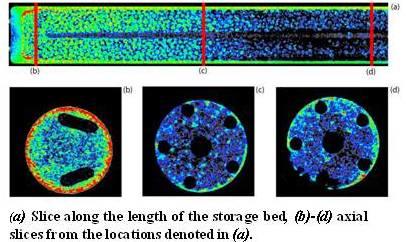Summary
Future hydrogen fuel cell vehicles will require hydrogen storage vessels that efficiently store and quickly release the hydrogen fuel. The hydrogen uptake in most storage materials strongly depends on the thermal environment, thus optimizing the fuel tank will require understanding the coupled heat and mass transport system.
Description

While many techniques exist to measure the volume average of the hydrogen uptake, to date no method exists that can measure the full three-dimensional hydrogen distribution within the storage vessel. In order to address this shortcoming, a prototype hydrogen storage bed has been studied using neutron tomography and radiography.
The prototype metal hydride bed consisted of a ≈90 % porous aluminum foam filled with LaNi4.78Sn0.22 powder. The foam provided structural integrity and enhanced the thermal conductivity of the system. A heater rod with four turns ran the length of the bed and was in contact with the aluminum foam to heat the metal hydride during hydrogen desorption. Hydrogen gas was introduced into and removed from the bed via a hollow stainless steel filter tube in the center. One aspect of this study involved acquiring two tomograms of the hydrogen storage bed: the first was after the bed was heated to 100 °C and evacuated to a pressure below 10-6 mbar; the second was after the bed was charged with about 12 standard liters of hydrogen. In figure 1 slices through the 3-D image of a hydrogen storage bed after the addition of 12 standard liters of H2 are shown. Red indicates higher concentration of hydrogen, black the absence of hydrogen. (a) Slice along the length of the storage bed, (b)-(d) axial slices from the locations denoted in (a). Hydrogen absorption is an exothermic process, and the hydrogen uptake decreases with increasing temperature. This is why hydrogen is seen to preferentially absorb along the outer circumference in (a), and accumulate towards the end of the storage bed. This is a result of the absorption of hydrogen by LaNi4.78Sn0.22 being exothermic coupled with reduced hydrogen uptake at higher temperatures. From neutron imaging an accurate picture of the hydrogen distribution in a storage bed can be obtained and compared with models of heat and mass transfer in order to optimize the storage and transport of hydrogen in the bed.

